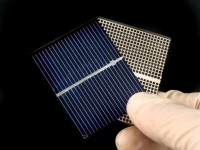Indoor Solar Power
April 17, 2012
Indoor Solar Power to Replace Batteries
 The term “indoor solar power” is misleading. An indoor solar panel does not absorb energy through a window from the sun, but from incandescent bulbs, fluorescent tubes, and light-emitting diodes (LEDS). And lately, there has been a growing interest in using indoor solar panels to run gadgets and appliances, instead of batteries or electrical outlets.
The term “indoor solar power” is misleading. An indoor solar panel does not absorb energy through a window from the sun, but from incandescent bulbs, fluorescent tubes, and light-emitting diodes (LEDS). And lately, there has been a growing interest in using indoor solar panels to run gadgets and appliances, instead of batteries or electrical outlets.
Indoor solar panels, otherwise know as photoelectric cells, were first invented at the Federal Polytechnic School of Lausanne, in Switzerland, in the 1990s. But recently, a new innovation by a firm based in Wales has created a new version of the photoelectric cell, with a special new dye-base, that has set the new record with an efficiency rating of 26% of light from bulbs being converted into electricity, which shatters the old record of 15%. This extra boost in efficiency might be exactly what the industry needed to widely commercialize these solar cells for indoor use.
These indoor, photoelectric, dye-based cells are similar to the silicon-based outdoor solar panels in that they both rely on a central semiconductor to assist in the conversion in a photon of light into an electric current. The difference is that in silicon cells the conversion happens directly, so the frequency of light absorbed is directly correlated with the physical properties of the silicon. But, in an indoor photoelectric cell, the special composition of the dye absorbs and can change the frequency of the light, which makes the dye-based cells more flexible than the silicon cell.
Advantages of the Indoor Solar Cell
- The composition of the dye can be changed in each cell for whatever frequency of artificial light is being used. A normal silicon-based solar panel is optimized only for sunlight.
- They work well in dim or diffused light. Silicon panels do not.
- Photoelectric cells have no rigid parts like a silicon panel. They can bend and are mechanically robust.
Companies are working hard to develop legitimate photoelectric cells that could one day power your TV remote controls, smoke detectors, clocks, or other household gadgets and appliances. These appliances would have a permanent built-in battery that would store extra power when the lights are out. Companies have even built prototypes of bags and jackets that have built-in photoelectric cells which are designed to charge digital cameras and mobile phones.
I am looking to buy thousands of photoelectric cells for indoor use. Need to recharge (4) 1.5v rechargeable batteries from indoor incandescent bulbs, fluorescent tubes, and or light-emitting diodes (LEDS). Size of photoelectric cell 50mm x 100mm.